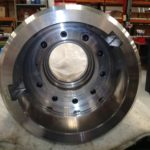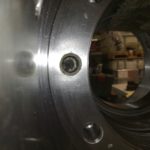Small internal diameters can be tricky to repair when they’re mis-machined. The benefit of selective plating is being able to isolate the bore with minimal masking to complete the plating operation. When one of the most advanced engineering facilities in Scotland experienced this situation, they called on SIFCO ASC to build their bores back to the size they require.
The Challenge
The engineering company manufacture large THRT Adaptors. Each component contains ten 0.750” diameter bores. When one of the bores was mis-machined to 0.755” a repair was needed. An out of tolerance bore could cause a variety of problems for the overall performance of the component. If for a bearing fit, the bearing would be too loose and spin. If the bore was meant for a pressure or interference fit, over machining would cause the fit to be loose not allowing the component to perform correctly.
Multiple repair options were investigated for resizing before choosing selective plating. Due to the size of the part in comparison to the size of the area needing repaired, tank plating was immediately disregarded. The part is too large, and the bore is far too small – requiring significant masking to make tank plating a viable option. While welding or thermal spray could achieve a successful result, the risk of thermal distortion involved in both processes was too great. In addition, both processes are unable to reach far enough into the bore to provide the correct thickness required.
Solution
This left selective plating as not just the only option, but the best application for the re-sizing repair. While selectively plating small internal diameters is a difficult job, the company fortunately approached the experts at SIFCO ASC.
The engineers at SIFCO ASC designed a special flow anode to ensure that proper thickness and uniformity was achieved. Because the required deposit for the application was AeroNikl 250®, the anode was made from a Nickel 200/201 alloy as so to not break down the tool or contaminate the solution during the plating process. The tool was also designed to be long enough to extend out of the bore and away from the face of the part. The flow holes then extended down the length of the entire tool allowing for solution to flow into the back of the bore.
The Result
The customer wanted 0.008” – 0.010” of AeroNikl 250® built up within each bore to give them enough material to machine back to size. Prior to the application, the parts were masked to protect to rest of the component. The initial pre-plate procedures were: Electroclean, Activator No. 2, Activator No. 3, and Nickel Special for bonding. AeroNikl® was then deposited to about 0.015” thick.
The final result of the application was extremely successful. With the specially designed tooling, SIFCO ASC was able to build up the deposit over the requirement of the customer, providing a good quantity of deposit material to machine back to the drawing tolerance of 0.750”. Without the technology of selective plating, a valuable machined component may have had to have been completely remanufactured – saving them time and expense, while meeting the challenges of salvaging critical components.
For more information on other applications in the oil & gas industry, visit our website. To download a pdf of this case study, click here.

 Chinese (Simplified)
Chinese (Simplified)  English (UK)
English (UK)  French
French  German
German  Spanish
Spanish  Swedish
Swedish 


